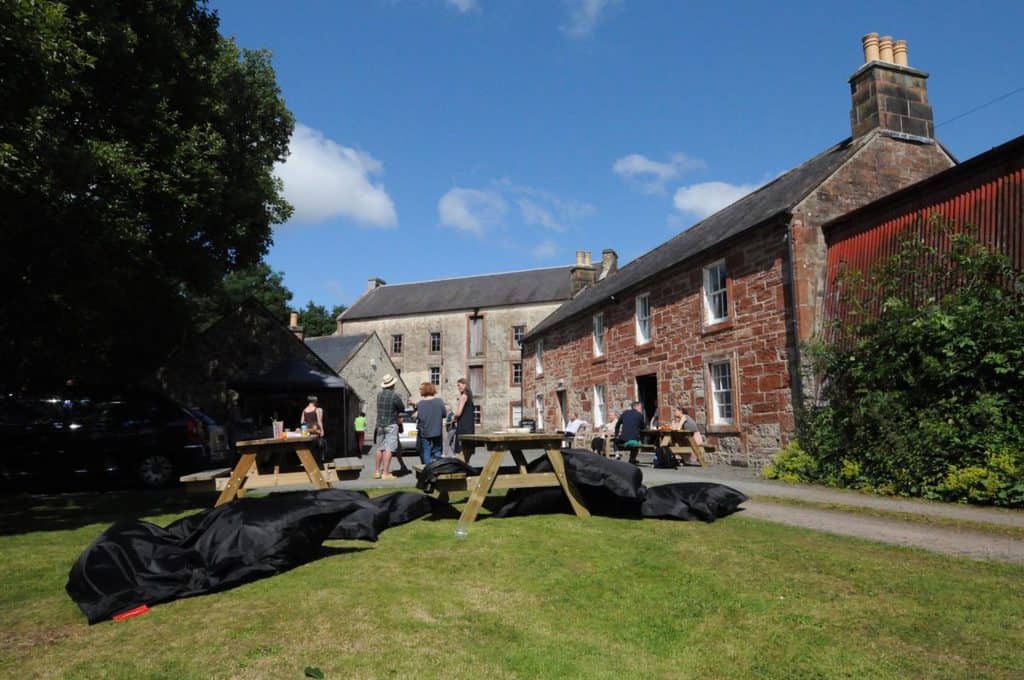This Autumn, CAMPLE LINE, a contemporary art venue in rural South West Scotland, will present a group exhibition entitled From narrow provinces and host a major new moving image commission by Rosalind Nashashibi. Located in Dumfries and Galloway, CAMPLE LINE is an independent arts organisation dedicated to presenting thought-provoking international contemporary art and film.
From narrow provinces brings together work by artists whose respective bodies of work take distinct approaches to materials, colour, shapes and structure, and operate in compelling junctures between painting and textiles, sculpture and architecture. The international roster of artists is: Ruth Laskey, Aleana Egan, Rana Begum, Claire Barclay and Alison Turnbull.
CAMPLE LINE will also host a new film work by Rosalind Nashashibi recently shown at Scottish National Gallery of Modern Art as part of Edinburgh Art Festival: Part One: Where there is a joyous mood, there a comrade will appear to share a glass of wine, 2018/ Part Two: The moon nearly at the full. The team horse goes astray, 2019. Shot in Lithuania, London, and Edinburgh, the film features the artist and her children, as well as close friends, which she considers extended family, and their open-ended discussion of space and time travel.
Two of Nashashibi’s other film works – Electrical Gaza and Vivian’s Garden – will be screened in order to provide a wider context around her practice. This project sees CAMPLE LINE collaborate with Edinburgh Art Festival as part of the PLACE [Platforms for Creative Excellence] Programme, which is supported with Scottish Government funding to present this work.
The programme runs from October 12 (preview and press view) until 14 December 2019. CAMPLE LINE is located rurally in the hamlet of Cample, close to Thornhill. From its rural base it aims to make a distinctive and quality contribution to visual arts programming in Scotland, connecting audiences and visitors from near and far to the practices of artists and filmmakers working internationally today.
*****
In From narrow provinces, each of the artists engages in investigations of material and process, investigations to which combinations of colour and shape are integral, as are the inherent behaviours of the materials and processes they choose (in the ways they sit, fold, fall, bend or weave).
They are drawn to practical, everyday materials including threads, pigments, cardboard, MDF, and Jesmonite, and pursue manual processes and methods of construction such as drawing, dyeing, weaving, dipping, printing or casting.
Though each of the artists employs a pared back visual and material language, Ruth Laskey, Alison Turnbull and Rana Begum most directly invoke geometry in relation to the grid, drawing on the logic of the serial unit, architectural form, or the loom to bring both structure and space to their work. Their works share a precision that is both laborious and lyrical, and an integrity born of concentration and restraint.
Laskey’s compact woven shapes provide a compelling counterpoint to the ‘improvised’ forms of Claire Barclay’s relief prints. Barclay has said of her early printmaking: ‘I have developed this departure in my practice in a very intuitive way, making prints spontaneously from images made using cut paper shapes.’
Barclay’s intuitive approach to shape and space and the relationship of her printmaking with her wider sculptural practice, offers something of a bridge to Aleana Egan’s work, and in particular to Egan’s wall-hung works made with lengths of cardboard strung together with thick coatings of paint and polyester filler to form sagging escutcheon shapes.
Of Egan’s sculptures, art critic Declan Long has said, ‘there is the simultaneous suggestion of stored-up reference and unyielding reticence.’ All of the works presented here share these aspects, being at once lucid and elliptical, determined in their presence (born out concentration or preoccupation) as well as suggestive with allusions and impressions that may unfold or be momentary.
Though the artists here have different generative starting points, these remain latent to the viewer, or are registered primarily at an associative or sensory level. These aspects combine in a quiet power that elicits heightened awareness or emotional response.
Meanwhile, Nashashibi’s most recent two-part film shown at Edinburgh Art Festival explores the importance of storytelling to our sense of community, and across the two parts, we follow the establishment of the bonds between the members of the extended family, which then fracture and disintegrate, before they are re-established in the final sequence of Part Two with the telling of a story.
In Electrical Gaza (2015), Nashashibi combines observations of domestic life in Gaza with sequences to reflect on issues of community. Images of families and friends engaging in everyday activities are punctuated with references to the local political conditions and shots of physical and imagined borders. Likewise, Vivian’s Garden (2017) depicts the relationship between two artists who are mother and daughter – Elisabeth Wild and Vivian Suter – in the connected houses they share in a jungle garden in Panajachel, Guatemala.
Director Tina Fiske has said: ‘Cample is a unique and special place, surrounded as it is by farms and fields and a joiners’ yard. This Autumn we are especially delighted to present the work of artists of international reputation such as Rana Begum, Alison Turnbull, Ruth Laskey Aleana Egan and Claire Barclay, and to be working with Edinburgh Art Festival through the PLACE Programme to bring a new work by Rosalind Nashashibi to Cample. These presentations will be a wonderful culmination to our first three years of public programme at CAMPLE LINE and point towards our ambitions beyond.’






